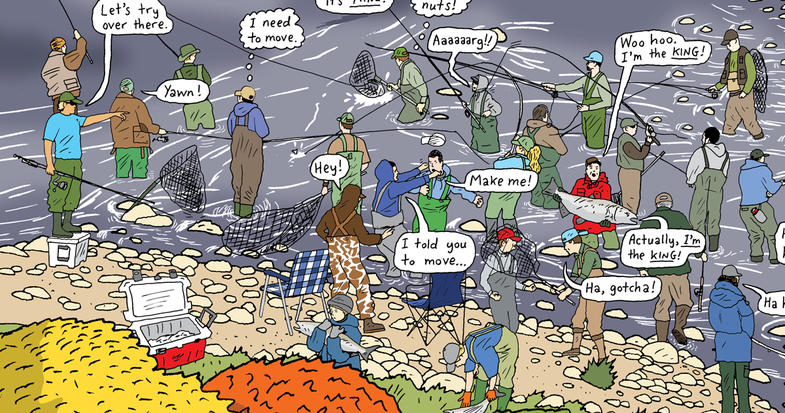Battle Lines: Don’t Wade into a War Zone Blind
Illustration by Peter Arkle Don’t wade into the war zone of a great lakes salmon tributary blind. Our combat fishing...

Illustration by Peter Arkle
Don’t wade into the war zone of a great lakes salmon tributary blind. Our combat fishing veteran’s plan will ensure victory will be yours, and you won’t need a medic.
With a push of water and a drop in air temperature, Great Lakes tributaries from Wisconsin to New York turn from quiet trout streams to salmon-choked highways every fall. The spawn is on, and anglers come from far and wide to take their shots at the hard-fighting king salmon coursing up the riffly flows. In fact, so many fishermen are driven by the drag-peeling runs of a king that tribs become crowded war zones, lined shoulder-to-shoulder with hopefuls looking to fish the juiciest holes. Of all the tributaries, New York’s Salmon River sees some of the heaviest droves, and veteran guide Scott Glazier has made a career out of keeping his clients on the fish and out of the fray. His tips will help you beat the masses, beat up more fish, and not get beat up yourself.

1. Sneak Up, Duck Low
›Deep, slow holes offer the best resting places for migrating salmon. Hundreds of fish can pile up in these spots, and so can hundreds of anglers. But Glazier says while many fishermen are amped to be in the honey hole, they’re actually turning it into a dead zone with each cast. “It doesn’t take long for salmon to shut down if they are being bombarded,” he says. “Eventually they get tired of being bumped and foul hooked and just move out of the way.” More often than not, instead of making a long run, the fish will simply slide to the top or bottom of the pool to escape the heaviest barrage. You may not be alone for long after you hook a fish in these areas, but you can at least get a few drifts on fish that are willing to strike before the crowd converges.
2. Pick a Pocket
›If you’re fishing solo or with just a buddy or two, Glazier says you can have a better day by avoiding community holes and “pocket fishing.” Salmon require quiet spots to spawn and rest as they move upriver, but that doesn’t mean they need a deep, wide pool. Anything from a short eddy, to a small break behind a rock, to a depression that creates a nook deeper than the surrounding water, is enough to hold a big king or three. “These areas won’t hold as many fish as the big pools, but they’ll hold the right fish,” he says. “There’s a better chance they haven’t been bombarded, so they’ll strike more readily. If you find the right little spot, it can give you an hour of good fishing without the crowds.”

3. Make Your Move
Salmon anglers naturally gravitate to pools that hold the most fish. But Glazier says it’s smart to remember that kings have to travel through not-so-good holding water to get to those spots. He says the shallow, fast runs—transition water—can actually provide some of the best and most exciting salmon fishing on the whole river. “Salmon that are moving through fast water don’t have time to study every fly or bait that comes by,” he says. “You get much more of a reaction bite here, which is what you need if you prefer swinging streamers and plugs instead of dead-drifting.” Best of all, transition runs are typically not crowded, and the heavier the crowds are in the pool below a transition run, the more fish will be annoyed into shooting upstream to your waiting lure or fly.
4. Catch an Early Flight
›Getting up at zero-dark-thirty is one way to claim a prime piece of salmon water, and during the peak of the season, sometimes there’s just no avoiding setting the alarms accordingly. If you do beat the late sleepers to a prime spot, another way you can earn a little extra space is by opting to flyfish, Glazier says. By nature, you need more room to whip a 10-weight around than you do to cast a spinning outfit or drift a center-pin rig. “When you flyfish, you make yourself big. Unless you’re dealing with some really bad seeds, the average guy is going to give you some room. Not only do anglers understand that a fly caster needs space to drift, but they’re not going to want to get hit by hooks or lead in your back cast.”